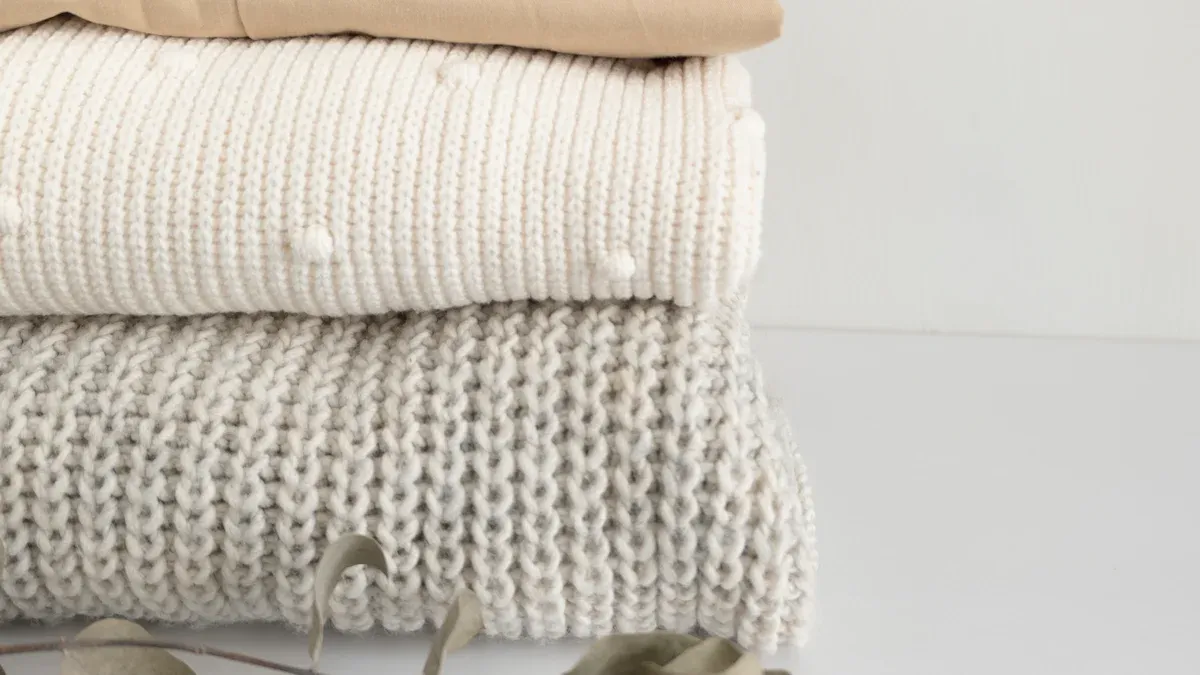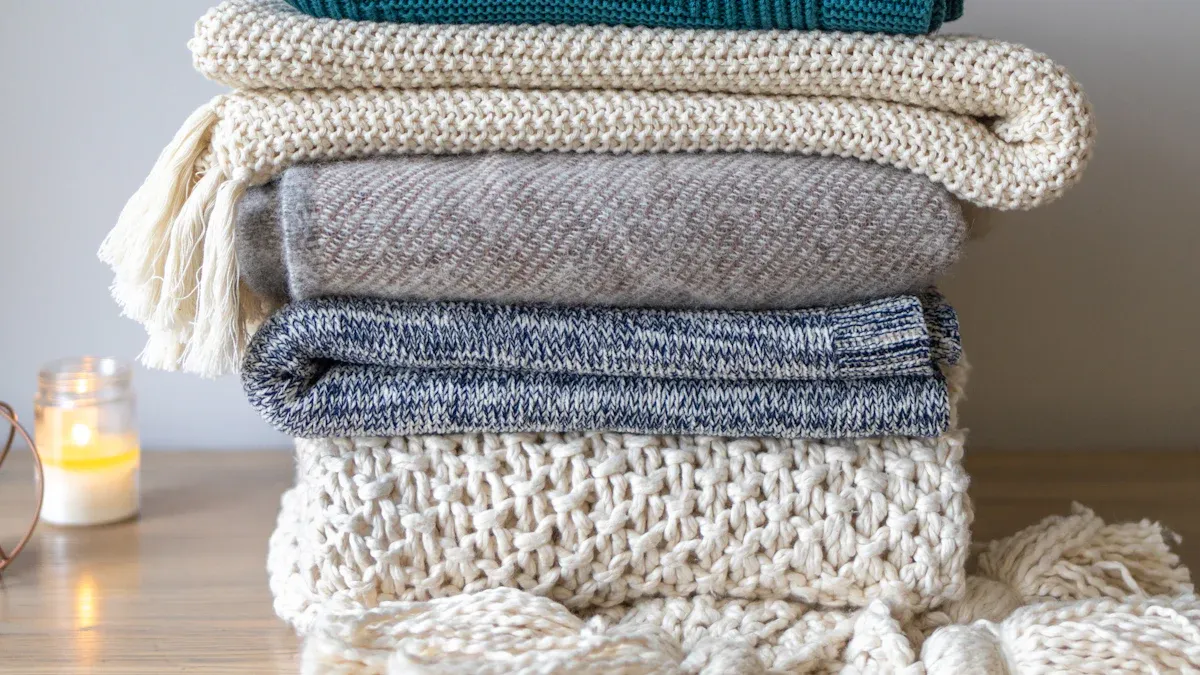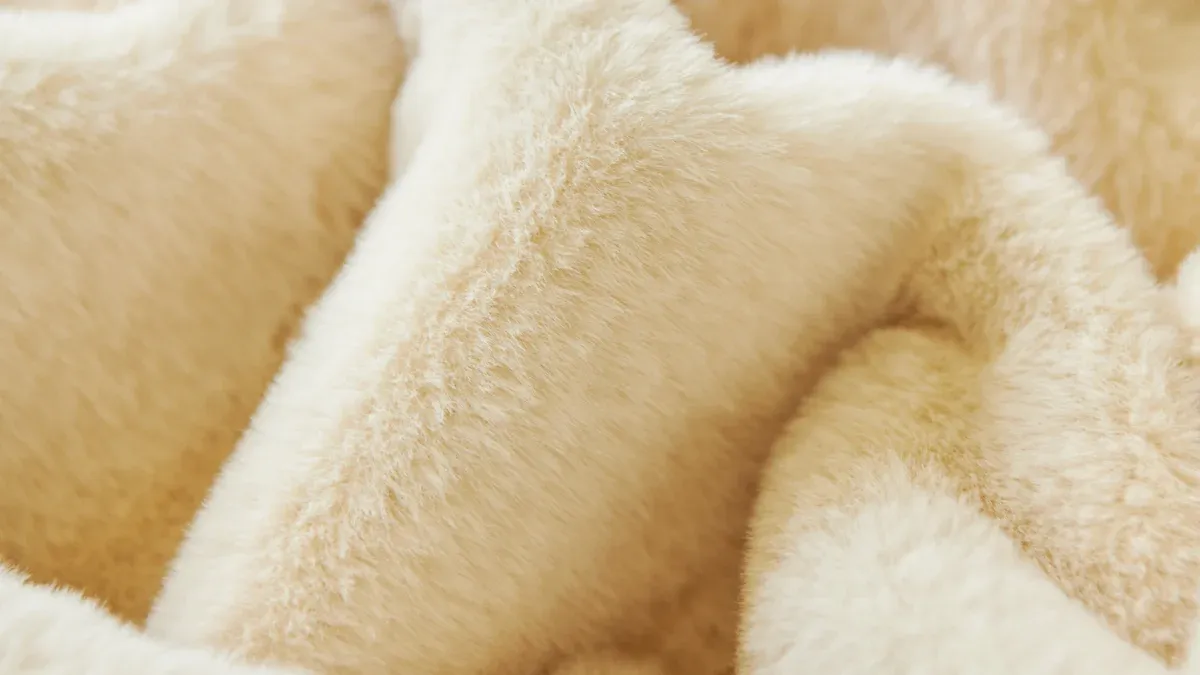Blanket Material Comparison

If you want the best blanket material, your choice depends on what matters most to you. You’ll find both natural and synthetic options on the market. Here’s how the popularity breaks down:
-
Cotton blankets lead the way, showing strong demand for natural fibers.
-
Polyester blankets hold 33.8% of the market, proving synthetic choices are also top picks.
Think about warmth, breathability, feel, care, and where you’ll use your blanket. Let’s explore your options together!
Key Takeaways
-
Choose cotton or linen for breathable comfort in warm climates. They help keep you cool and dry.
-
Opt for wool or fleece when you need warmth. These materials trap heat and keep you cozy during cold nights.
-
Consider faux fur or minky for a luxurious feel. They provide plush comfort and are perfect for snuggling.
-
Select bamboo or cooling blankets if you sleep hot. These materials wick away moisture and promote airflow.
-
Always check care instructions before washing. Different materials require different care to maintain their quality.
Blanket Material Overview

Types of Blanket Material
You have so many choices when it comes to blanket material. Each one brings something special to the table. Cotton stands out for its breathability and easy care. Linen feels cool and crisp, perfect for summer nights. Wool keeps you warm and cozy, even on the coldest days. Minky and faux fur offer a plush, luxurious feel that’s hard to resist. Silk feels smooth and cool against your skin. Rayon and bamboo give you softness and moisture-wicking power. Acrylic and chenille add warmth and style, while sherpa and fleece deliver softness and warmth for snuggling. Cooling blankets use special fabrics to help you stay comfortable in hot weather.
Here’s a quick look at some of the most popular blanket materials:
|
Material |
Description |
|---|---|
|
Cotton |
Breathable, hypoallergenic, durable, and easy to clean. Provides warmth when layered. |
|
Cashmere |
Luxurious, extremely soft and warm, lightweight but requires special care. |
|
Flannel |
Soft texture, locks in body heat, breathable, ideal for layering in cold weather. |
You can see that each blanket material has its own strengths. Some focus on warmth, while others shine in breathability or softness.
Key Comparison Criteria
When you pick a blanket, you want to know what makes each material different. Here are the main things to think about:
-
Warmth: How well does the blanket keep you warm?
-
Breathability: Does it let air flow, or does it trap heat?
-
Feel: Is it soft, smooth, or textured?
-
Care: Is it easy to wash, or does it need special attention?
-
Best Uses: Where does this blanket material work best—on your bed, couch, or for travel?
Tip: Think about your climate and how you plan to use your blanket. This will help you choose the right material for your needs.
Blanket Material Comparison Guide
At-a-Glance Table
Here’s a handy table to help you compare popular blanket materials. You can quickly see how each one stacks up for warmth, breathability, feel, care, and best uses.
|
Blanket Material |
Warmth Level |
Breathability |
Feel |
Care |
Best Uses |
|---|---|---|---|---|---|
|
Cotton |
Moderate |
High |
Soft |
Moderate |
Year-round, spring/summer |
|
Wool |
Very High |
Good |
Soft |
Moderate |
Winter, cold climates |
|
Fleece |
Medium-High |
Medium-High |
Soft |
Easy |
Everyday, travel, layering |
|
Sherpa |
High |
Medium |
Plush |
Machine wash |
Cold nights, lounging |
|
Faux Fur |
Very High |
Low |
Luxurious |
Delicate wash |
Decorative, cold weather |
|
Bamboo |
Moderate |
High |
Soft |
Moderate |
Hot sleepers, eco-friendly |
|
Silk |
Low |
High |
Smooth |
Delicate |
Summer, luxury bedding |
|
Acrylic |
High |
Moderate |
Soft |
Easy |
Style, warmth, easy care |
|
Chenille |
Moderate |
Moderate |
Velvety |
Moderate |
Decorative, cozy throws |
|
Cooling |
Low |
Very High |
Smooth/Soft |
Varies |
Hot climates, summer nights |
Tip: If you want a blanket for cold nights, wool or faux fur will keep you toasty. For summer, cotton or cooling materials work best.
Quick Reference Guide
-
Cotton: You get a soft, breathable blanket that’s easy to care for. Great for all seasons.
-
Wool: You’ll stay warm even in freezing weather. Wool also wicks moisture, so you won’t feel sweaty.
-
Fleece: You enjoy lightweight warmth and easy washing. Fleece dries fast and feels soft.
-
Sherpa: You’ll love the plush texture. Sherpa works well for snuggling on chilly evenings.
-
Faux Fur: You get a heavy, luxurious feel. Faux fur looks stylish and keeps you warm, but needs gentle washing.
-
Bamboo: You’ll notice softness and breathability. Bamboo is perfect if you want something eco-friendly and cool.
-
Silk: You feel smoothness and coolness. Silk adds a touch of luxury but needs delicate care.
-
Acrylic: You get warmth and softness with easy care. Acrylic blankets add color and style to your space.
-
Chenille: You enjoy a velvety texture. Chenille works well for decorative throws and cozying up.
-
Cooling: You stay comfortable in hot weather. Cooling blankets use special fabrics to wick away heat.
If you want a blanket material that matches your lifestyle, think about how warm you want to feel, how much you sweat, and how much effort you want to put into washing. You can find the perfect fit for your bed, couch, or travel bag.
Cotton & Linen Blankets
Material Properties
When you look at cotton and linen blankets, you’ll notice some clear differences. Cotton gives you a clean, smooth finish, while linen has a crumpled, relaxed look. Both materials are popular for bedding, but cotton usually feels more insulating. Linen stands out for its durability and eco-friendly qualities. Here’s a quick table to show you what makes linen special:
|
Property |
Description |
|---|---|
|
Wicking & Thermoregulating |
Lifts sweat away from your skin, cools you when hot, traps heat when cold. |
|
Fluff or Lint |
Produces very little fluff, great for sensitive users. |
|
Durability |
Gets stronger when wet, machine washable. |
|
Hypoallergenic |
Good for allergies and sensitive skin. |
|
Sustainability |
Small environmental footprint, biodegradable. |
Cotton, on the other hand, is easy to care for and offers a crisp, comfortable feel.
Warmth & Breathability
You’ll find both cotton and linen blankets breathe well, making them comfortable all year. Cotton keeps you warm in cooler weather, while linen’s natural fibers wick away moisture and let air flow, keeping you cool. In summer, cotton’s moisture-wicking and linen’s cooling effects help you avoid overheating. In winter, these blankets provide warmth without making you feel stuffy.
Feel & Comfort
Cotton blankets feel soft and warm, perfect for snuggling on the couch or bed. Linen feels lightweight and breathable, which works well if you live in a warmer climate or tend to sleep hot. Cotton is easier to refresh after washing, while linen offers a crisp texture and stands up to years of use. Your choice often comes down to whether you want more warmth or better ventilation.
Care Tips
-
Cotton: Wash in a front-loading machine on a gentle cycle with low heat. Use a mild liquid detergent without bleach. Tumble dry on medium to high heat, but remove while slightly damp to protect the fibers.
-
Linen: Use a gentle cycle and pre-dilute your detergent. Tumble dry on low or no heat for pure linen. Remove while still damp to keep the fabric strong.
Tip: Always avoid harsh detergents and over-drying to extend the life of your blankets.
Best Uses
Cotton and linen blankets fit almost any climate. In hot weather, they help you stay cool and dry. When it gets chilly, they offer just enough insulation to keep you comfortable. You can use these blankets on your bed, as a throw on the couch, or even for travel. If you want a Blanket Material that works year-round and feels great, cotton and linen are top choices.
Wool Blankets
Material Properties
When you pick up a wool blanket, you’re holding something special. Wool stands out as a 100% natural, renewable resource. You get a sustainable Blanket Material that’s biodegradable and gentle on the planet. Wool also brings temperature-regulating powers, UV protection, and fire resistance. If you have allergies, wool’s hypoallergenic and anti-bacterial qualities make it a smart choice. You’ll notice it’s breathable and moisture-wicking, so you stay comfortable without feeling clammy.
-
Sustainable and renewable
-
Temperature-regulating
-
UV-protective
-
Hypoallergenic
-
Fire and flame-resistant
-
Breathable and moisture-wicking
-
Anti-dust and anti-bacterial
Warmth & Breathability
Wool blankets keep you cozy even when the temperature drops. The fibers trap heat, creating natural insulation that synthetic blankets just can’t match. Wool’s breathability helps balance your body temperature, so you don’t overheat or get sweaty. Unlike synthetics, wool wicks moisture away and prevents that damp feeling. You’ll sleep comfortably all night, whether it’s chilly or just a little cool.
-
Wicks moisture away for dry comfort
-
Regulates temperature with air pockets
-
Synthetics trap heat and moisture, wool does not
Feel & Comfort
You’ll love the warmth wool blankets provide. They feel snug and secure, perfect for cold nights. Wool fibers trap heat, making these blankets ideal for winter or drafty rooms. Some people find wool’s texture a bit coarse, especially if you have sensitive skin. If you want extra softness, look for blankets with a finer weave or a blend.
-
Moisture-wicking comfort
-
Texture may feel coarse to some
Care Tips
Taking care of your wool blanket helps it last for years. Always check the label before washing. Use a cold setting and minimum spin if you machine wash. Remove the blanket right away, reshape it while damp, and dry flat or line dry. For hand washing, use warm water and gentle detergent, then air dry flat. Avoid hot water and sudden temperature changes to prevent shrinking. Use a detergent made for wool, and skip heavy-duty cleaners. If you spot clean, use a lint-free cloth and dab gently. Pilling happens sometimes, but you can fix it with a lint roller or de-pilling comb.
-
Remove and reshape while damp, dry flat or line dry
-
Use PH neutral, mild liquid detergent
-
Avoid hot water and temperature changes
-
Hand wash gently if needed
-
Professional cleaning for tough stains
Tip: Always avoid wringing or twisting your wool blanket. This keeps the fibers strong and prevents damage.
Best Uses
Wool blankets shine in colder climates. You can use them on your bed, as a poncho, or even as a coat when you need extra warmth. They work great for outdoor activities, doubling as insulated seats or pillows. If you’re camping, a wool blanket can become a temporary shelter or help keep firewood dry. Brightly colored wool blankets can even serve as emergency signal panels. You’ll find them handy for travel, outdoor adventures, and cozy nights at home.
-
Use as bedding, ponchos, coats, or insulated seats
-
Great for camping, travel, and outdoor comfort
-
Emergency shelter or signal panel
-
Keeps firewood dry
Fleece & Sherpa Blankets

Material Properties
You might wonder what sets fleece and sherpa blankets apart. Both use synthetic polyester, but their textures and features feel different. Here’s a quick table to help you compare:
|
Property |
Fleece |
Sherpa |
|---|---|---|
|
Material Composition |
Synthetic fabric (polyester) |
Synthetic fabric (polyester) |
|
Surface Texture |
Smooth on both sides |
Velvety-smooth and textured, wool-like side |
|
Warmth |
Lightweight, good warmth |
Enhanced insulating capabilities |
|
Moisture-Wicking Ability |
Known for moisture-wicking properties |
Less emphasis on moisture-wicking |
|
Care |
Durable, less prone to pilling |
Requires more care to maintain texture |
|
Cost |
Generally lower cost |
Typically higher cost |
Fleece feels smooth and light, while sherpa gives you a plush, wool-like side that looks and feels extra cozy.
Warmth & Breathability
You’ll notice sherpa blankets keep you warmer than most other synthetic options. Their thick, plush texture mimics real sheep wool, locking in heat. Fleece blankets feel lighter and pack down small, so you can take them anywhere. Sherpa offers extreme warmth and breathability, making it perfect for cold nights. Fleece stands out for its moisture-wicking ability, keeping you dry and warm even if you tend to sweat.
-
Sherpa blankets deliver maximum warmth and breathability.
-
Fleece blankets are lightweight, easy to carry, and wick away moisture.
Feel & Comfort
If you love soft, snuggly blankets, you’ll enjoy both fleece and sherpa. Many blankets combine the two, with thick sherpa on one side and velvety fleece on the other. This dual-sided design gives you the best of both worlds. Users often say these blankets feel unmatched in quality, with a higher GSM (grams per square meter) adding to the luxurious comfort. You’ll notice the difference as soon as you wrap up—these blankets feel plush, warm, and inviting.
-
Plush sherpa fleece blankets offer thick, soft comfort.
-
Dual-sided designs enhance the cozy feel and quality.
Care Tips
You want your blanket to last, so proper care matters. Machine wash your fleece or sherpa blanket in cold water with a gentle detergent. Use only non-chlorine bleach if needed. Skip the dry cleaner. For hand washing, fill a tub or sink with cold water and spot treat any stains. Gently agitate, rinse until clear, and dry at low temperatures or air dry. Fluffing in the dryer helps restore softness.
Tip: Always avoid high heat to keep your blanket fluffy and prevent damage.
Best Uses
Fleece and sherpa blankets shine in cold weather. Fleece works well for winter, travel, or layering on your bed. Sherpa blankets bring luxurious softness, making them perfect for cozy indoor settings. You’ll love using sherpa for lounging on the sofa or adding comfort during chilly nights. If you want a Blanket Material that keeps you warm and feels amazing, these are top picks for winter comfort.
Faux Fur & Minky Blankets
Material Properties
You might love the look and feel of faux fur and minky blankets. Both use high-quality polyester, but each brings something unique to your home. Faux fur mimics the look of real animal fur, giving you a touch of luxury without any animal products. Minky blankets stand out for their incredible softness and durability. Take a look at what makes minky special:
|
Characteristic |
Minky Blankets |
|---|---|
|
Softness |
Incredibly soft to the touch, providing a cozy and luxurious feel. |
|
Durability |
Strong and resistant to wear and tear, making them long-lasting. |
|
Warmth |
Excellent at retaining heat, keeping you warm and comfortable. |
|
Ease of Care |
Easy to machine wash and dry without losing softness or shape. |
|
Safety |
Non-toxic and hypoallergenic, suitable for sensitive skin. |
|
Excellent dyeability |
Suitable for colorful prints and customization. |
Warmth & Breathability
You’ll notice both faux fur and minky blankets keep you warm, but they differ in breathability. Faux fur has a dense pile, so it traps heat and offers more insulation than most fabrics. This makes it perfect for cold climates. Minky blankets also provide high warmth, but they allow a bit more airflow.
|
Fabric Type |
Warmth |
Breathability |
|---|---|---|
|
Minky |
High |
Moderate |
|
Faux Fur |
Very High |
Low |
Tip: If you want a Blanket Material for chilly nights, faux fur and minky are top choices.
Feel & Comfort
You’ll love how plush and fluffy these blankets feel. Minky blankets get rave reviews for their extra plushness and softness. Faux fur feels thick and luxurious, making it a favorite for snuggling. Both types use high-quality polyester, so they resist fading and keep their warmth over time.
|
Attribute |
Description |
|---|---|
|
Plushness |
Minky blankets are extra plush and fluffy, providing a cozy feel. |
|
Softness |
The fabric is noted for its softness, enhancing the overall comfort. |
|
Durability |
The high-quality polyester prevents color fading and maintains warmth. |
Care Tips
You want your blanket to stay soft and beautiful. Here’s how you can care for faux fur and minky:
-
Check care labels for instructions.
-
Machine wash on a gentle cycle with cold water and mild detergent.
-
Avoid fabric softeners to keep the texture.
-
Air dry or use a no-heat dryer setting.
-
Spot clean minor stains and wash lightly used blankets once or twice a season.
-
Fluff faux fur gently with your hands or a soft-bristled brush after drying.
Note: For minky, wipe off dirt before washing and finish drying by hanging if needed.
Best Uses
Faux fur and minky blankets add comfort and style to any room. You can drape them over your couch or bed for a touch of class. They work well as stylish throws in living rooms and make great gifts. If you want a blanket that feels as good as it looks, these are excellent picks for both warmth and home decor.
Silk, Rayon & Bamboo Blankets
Material Properties
You might notice that silk, rayon, and bamboo blankets all feel smooth and lightweight. Silk comes from silkworms and gives you a natural, luxurious touch. Rayon and bamboo both start as plant fibers, but manufacturers process them to create soft, silky threads. Bamboo stands out for being eco-friendly and naturally hypoallergenic. Rayon feels similar to silk but costs less. Each of these options brings something special to your bedding.
|
Material |
Source |
Notable Features |
|---|---|---|
|
Silk |
Silkworms |
Natural, shiny, luxurious |
|
Rayon |
Plant-based |
Soft, drapes well, affordable |
|
Bamboo |
Bamboo pulp |
Eco-friendly, hypoallergenic |
Warmth & Breathability
You get excellent breathability with all three materials. Silk keeps you cool in summer and warm in winter because it adjusts to your body temperature. Rayon and bamboo both wick away moisture, so you stay dry and comfortable. Bamboo especially shines if you sleep hot or live in a humid area. These blankets work well for year-round comfort.
Feel & Comfort
If you love a soft, smooth feel, you will enjoy these blankets. Silk feels cool and gentle against your skin. Rayon offers a silky texture without the high price tag. Bamboo feels soft and light, making it perfect for sensitive skin. You can wrap up in any of these and feel pampered.
Tip: If you want a Blanket Material that feels luxurious but stays breathable, try silk, rayon, or bamboo.
Care Tips
You need to handle these blankets with care. Silk requires hand washing or a delicate machine cycle with cold water. Always air dry silk to keep it looking new. Rayon and bamboo can usually go in the washing machine on a gentle cycle, but avoid high heat. Use mild detergent and skip the bleach.
-
Wash silk by hand or on delicate
-
Air dry silk, avoid wringing
-
Machine wash rayon and bamboo on gentle
-
Use cold water and mild detergent
Best Uses
You can use these blankets for summer bedding, layering, or as a light throw. Silk works best for luxury bedding or if you want a cooling effect. Bamboo and rayon fit well in guest rooms, kids’ rooms, or anywhere you want softness and breathability. These blankets also make thoughtful gifts for anyone who values comfort and style.
Acrylic & Chenille Blankets
Material Properties
You might notice acrylic and chenille blankets look stylish and feel soft. Acrylic comes from synthetic fibers. It mimics the warmth and softness of wool but costs less. Chenille stands out for its velvety texture and plush appearance. You often see chenille made from cotton, polyester, or a blend. Both types resist fading and keep their color bright. If you want a Blanket Material that adds a pop of color to your room, these are great choices.
Warmth & Breathability
Acrylic blankets trap heat well. You stay warm on chilly nights. They do not breathe as much as natural fibers, so you might feel hot if you use them in summer. Chenille offers moderate warmth. It feels cozy but does not overheat you. You get a nice balance for most seasons.
|
Blanket Type |
Warmth |
Breathability |
|---|---|---|
|
Acrylic |
High |
Moderate |
|
Chenille |
Moderate |
Moderate |
Feel & Comfort
You will love the soft touch of both acrylic and chenille. Acrylic feels light and fluffy. It does not itch like some wool blankets. Chenille feels velvety and smooth. It drapes nicely over your bed or sofa. If you want a blanket that feels gentle on your skin, try chenille.
Care Tips
You can wash acrylic blankets in the machine. Use cold water and a gentle cycle. Tumble dry on low or air dry. Chenille needs a bit more care. Wash it on a gentle cycle and avoid high heat. Lay it flat to dry to keep its shape. Always check the care label first.
Tip: Use a laundry bag for chenille to prevent snags.
Best Uses
Acrylic blankets work well for everyday use. You can use them on your bed, couch, or even for picnics. Chenille blankets shine as decorative throws. They add style to your living room or bedroom. If you want comfort and color, these blankets fit almost any space.
Cooling Blanket Material
Material Properties
You want a blanket that keeps you cool, not sweaty. Cooling blankets use special fibers and smart designs to help you stay comfortable. Many brands use materials like bamboo, Tencel, or advanced microfibers. Some even add cooling gel or phase-change technology. These features pull heat away from your body and help you sleep better. You might notice these blankets feel lighter and smoother than regular ones. They often have a silky finish and a thinner profile.
Breathability & Temperature Control
Cooling blankets shine when it comes to airflow. The fabric lets air move freely, so you do not feel trapped under heavy layers. If you get hot at night, you will love how these blankets wick away sweat and dry quickly. Some cooling blankets adjust to your body temperature. You stay cool in summer and comfortable in warmer rooms. This makes them a great choice for hot sleepers or anyone living in a humid climate.
Tip: If you want the best temperature control, look for blankets with moisture-wicking or phase-change materials.
Care Tips
You do not need to stress about cleaning most cooling blankets. Many are machine washable. Use cold water and a gentle cycle. Avoid bleach and fabric softeners because they can damage the cooling fibers. Tumble dry on low or hang to dry. Always check the care label first. If your blanket has special cooling technology, follow the instructions closely to keep it working well.
Best Uses
Cooling blankets work best in hot weather or for people who sleep warm. You can use them as your main blanket in summer or layer them under a heavier one in winter. They also make great travel companions for road trips or camping. If you want a Blanket Material that helps you stay cool and comfortable, cooling blankets are a smart pick.
Choosing Blanket
Material
Matching to Your Needs
You want a blanket that fits your life, not just your bed. Start by thinking about what matters most to you. Do you have allergies or sensitive skin? Maybe you live in a hot or cold climate. Your comfort and health come first.
-
Lightweight cotton or linen works best for warm climates.
-
Heavier wool or fleece keeps you cozy in colder places.
-
If you have allergies, look for hypoallergenic options like bamboo or Tencel.
-
Think about how easy it is to wash and care for your blanket.
-
Pick a style and color that matches your room.
If you deal with allergies, asthma, or sensitive skin, the wrong blanket can disrupt your sleep. Down-alternative blankets are made for people who can’t tolerate feathers. Bamboo and Tencel are naturally hypoallergenic and breathable, keeping irritants like dust mites at bay.
Seasonal Considerations
Blankets are not one-size-fits-all. You might need different types for each season. Here’s a quick guide to help you choose:
-
Climate
-
Budget
-
Desired level of softness and warmth
In summer, you want something light and breathable. Cotton, linen, or cooling blankets help you stay comfortable. For winter, reach for wool, fleece, or sherpa to trap heat and keep you warm. If you live somewhere with big temperature swings, try layering different blankets so you can adjust as needed.
Care & Maintenance
You want your blanket to last. Always check the care label before washing. Some materials, like cotton and fleece, are easy to toss in the machine. Others, like silk or wool, need gentle care. Use mild detergent and avoid high heat. For delicate blankets, air drying helps keep them soft and looking new.
|
Material |
Easy Care |
Special Care Needed |
|---|---|---|
|
Cotton |
|
|
|
Fleece |
|
|
|
Wool |
|
|
|
Silk |
|
|
|
Bamboo |
|
|
|
Faux Fur |
|
When you pick the right Blanket Material, you get comfort, style, and easy care all in one.
You’ve seen how each blanket material brings something unique. Cotton and linen keep you cool. Wool and fleece offer warmth. Faux fur and minky add luxury. Silk, bamboo, and rayon feel smooth and light. Acrylic and chenille bring style. Cooling blankets help you beat the heat.
-
Choose cotton or linen for breathability.
-
Pick wool or fleece for cold nights.
-
Try faux fur or minky for plush comfort.
Tip: Trust your comfort preferences and climate. You’ll find the perfect blanket for your space and lifestyle.
FAQ
What blanket material is best for hot sleepers?
If you sleep hot, try bamboo, cotton, or cooling blankets. These materials breathe well and wick away moisture. You’ll stay cool and dry all night.
Can you machine wash all blanket materials?
No, you can’t wash every blanket in the machine. Cotton, fleece, and bamboo usually handle machine washing. Wool, silk, and faux fur need gentle care or hand washing. Always check the care label first.
Which blanket material is most hypoallergenic?
Bamboo and cotton work best if you have allergies. These materials resist dust mites and mold. You’ll breathe easier and sleep better with them.
How do you keep blankets soft after washing?
Use a gentle detergent and skip fabric softeners. Dry on low heat or air dry. Fluff your blanket after drying to keep it soft and cozy.
What’s the warmest blanket material for winter?
Wool and faux fur give you the most warmth. These blankets trap heat and keep you toasty on cold nights. Perfect for winter or chilly rooms.
Quick Link
Contact
Phone
0086-574-87208762
info@vekenindustry.com
Address
Floor 18, Yuehu Jinhui Tower, 225 Liuting Street Haishu District,Ningbo,China 315010
Copyright CleanMonk © 2025 All Rights Reserved




